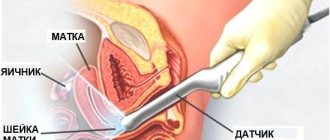Periodic discharge from the genital tract accompanies a woman for almost the entire 9 months of bearing a baby. Some of them are a variant of the norm, others are a signal of a pathological process.
The 40th week of pregnancy is the period when the expectant mother expects the birth of her little one any day now. At this time, many women are especially attentive to their body, paying attention to any changes in their usual state. Vaginal discharge may also change. What does this or that discharge indicate at 40 weeks of pregnancy? What situations require seeking medical help?
Discharge at 40 weeks of pregnancy - important nuances
A pregnant woman should pay attention not only to the appearance of vaginal discharge (color, consistency), but also to such associated factors as:
- Volume of discharge.
- Their smell. Normally, the discharge should have no odor. If a sharp, unpleasant “sweet breath” appears, a woman should consult a gynecologist.
- Presence of itching. This symptom almost always indicates the presence of thrush. Be sure to tell your doctor about this. If the diagnosis is confirmed, sanitation of the birth canal is necessary. Otherwise, as the baby passes through the birth canal, the fungal infection will “cling” to the child.
- The presence of discomfort in the area of the external genitalia.
- Pain (sharp or aching) in the abdomen or lower back.
As the due date approaches, a woman may notice an increase in the amount of discharge, especially soon after waking up. It is important to be able to recognize alarming symptoms and notify your gynecologist in a timely manner.
Discharge at 40 weeks of pregnancy: the plug comes off
The mucus plug located in the cervix reliably protected the baby from all kinds of infections and negative external influences throughout the entire 40 weeks. Hormonal changes that occur in anticipation of labor prepare the cervix for further dilatation. That is why a woman often notes a change in the nature of the discharge. In order for the baby to pass through a woman’s birth canal, the uterine cervix needs to get rid of the plug. This process can last several hours, or it can take up to two weeks. If the plug comes out completely at once, the woman may see a fairly dense clot of mucus. The discharge of the mucus plug is accompanied by discharge. Their color can be any - yellow, beige, pink, brown, transparent with streaks of blood. Partial or complete release of the plug is often accompanied by discharge, incl. at the 40th week of pregnancy, similar to those during menstruation. The inclusions of blood are created by capillaries that rupture as a result of the gradual expansion of the cervix.
Important! After the mucous plug has passed, it is recommended that a pregnant woman refrain from taking a bath, going to the pool, having intimate relationships with a partner, or swimming in open water. Carefully monitor hygiene, because... Now the uterus is open to any infection.
In the second trimester
The expectant mother should watch the discharge in the second trimester with special attention, since it is now that the appearance of brownish or red mucus is considered dangerous.
Placental abruption
The detached placenta can only supply the baby with oxygen and substances necessary for its full development for some time. When placental abruption occurs, uterine bleeding often occurs, threatening the life of the mother and child. Therefore, you need to see a doctor as soon as possible.
The problem is more typical for women who smoke, as well as expectant mothers suffering from high blood pressure. In addition, placental abruption occurs in the presence of the following problems:
- scars on the uterus after an abortion or cesarean section;
- umbilical cord too short;
- abdominal trauma received during pregnancy.
With detachment, spotting and heavy discharge may appear, reminiscent of menstruation. At this time, the woman feels tension and nagging pain in the lower abdomen. Detachment can be complete or partial: in the first case, the entire placenta is exfoliated (which rarely happens), in the second - a small part of it.
When placental abruption occurs, the blood supply to the fetus is disrupted
If placental abruption occurs in the third trimester, a cesarean section is performed. If possible, doctors try to delay surgery until 30–36 weeks to save the baby. If immediate intervention is required, they perform emergency CS surgery.
Placenta previa
Placenta previa is the partial or complete closure of the uterine os by the placenta. When this happens, the growing baby puts pressure on the placenta, which can cause blood vessels to become damaged, resulting in bleeding. Due to high pressure, there is a risk of detachment, but most often such complications can be avoided.
With this pathology, delivery is carried out by caesarean section. The woman is under special supervision of doctors who monitor the condition of the fetus, because there is a risk of squeezing vital vessels and causing oxygen starvation. Placenta previa is characterized by abdominal pain and pinkish-red discharge.
Placenta previa - partial or complete closure of the uterine os by the placenta
Premature birth
Premature birth occurs in 10% of women. They represent childbirth with an insufficiently mature fetus. You can tell when they are starting by the blood or watery fluid coming out of the vagina. The discharge may also be pinkish or brownish. They do not stop, but become more and more abundant.
Premature birth can be determined by additional signs:
- diarrhea or intestinal cramps;
- cramps as during menstruation;
- a feeling of pressure in the back or dull pain in the lower back;
- pain or pressure in the groin, pelvis or thighs.
If, with some of the above symptoms, you experience more than four contractions in an hour, then rush to the doctor.
The onset of preterm labor is characterized by diarrhea, blood, brownish, pinkish mucus or watery fluid from the vagina
One of my friends had a premature birth, which ended with the birth of her baby. At that time she was just over seven months pregnant. For several days her lower back hurt at night, which she told the doctor about. The gynecologist prescribed Magnesia injections. But after 3 days she began to have brown discharge and pain in the abdominal area. My friend called the ambulance service, and in the morning she was feeding her baby. Of course, she spent a lot of time in the maternity hospital, and then in the children's hospital (about two months), but now everything is fine with the baby - he is already 2 years old.
What kind of discharge may bother you at 40 weeks of pregnancy?
How to distinguish physiological secretions from secretions during pathological processes?
Brown discharge at 40 weeks of pregnancy
Normally, labor can begin at any time after the 38th week of pregnancy. That is why the appearance of brown discharge on the eve of PDP often indicates the approach of labor. Discharge may appear several hours or several days before birth. The appearance of a bloody brown “smudge” most often indicates the maturity of the cervix and its readiness to open. Often, discharge of a similar color accompanies the release of a mucus plug. Some time after examining the pregnant woman in the gynecological chair, it is also possible that a brown “smudge” may appear from the genital tract. It is important to monitor the general condition and the presence of accompanying symptoms. The brown secretion should not have an unpleasant odor.
40 weeks pregnant: pink discharge
The appearance of pink (not to be confused with scarlet!) discharge after the 38th week of gestation is more often the norm than a pathology. A secretion of this color often accompanies the release of a cervical plug. The mucus may be completely pink or have pink streaks. The amount of discharge can be moderate or quite heavy. The pale pink color of the secretion is normal if it does not contain an admixture of scarlet blood. An increase in the intensity of the red tint of the discharge indicates the need to urgently contact a medical facility.
Bloody discharge at 40 weeks of pregnancy
As the due date approaches, a woman’s body is actively preparing for the birth of a new life. Brown discharge, as well as the presence of bloody streaks in the clear secretion, is most often a normal variant. At the same time, the discharge of scarlet blood from a woman’s genital tract, even on the eve of PDR, is a dangerous symptom that requires immediate attention to a medical facility. The appearance of bleeding may indicate placental abruption. This condition primarily threatens the life of the child - placental rejection leads to fetal hypoxia; if the area of detachment is large, the baby’s death can occur within a matter of minutes. The appearance of bloody discharge in the 40th week also threatens the woman herself. Opening bleeding threatens the expectant mother with a large loss of blood. In this case, the location of the placenta (normal or low) does not matter. The appearance of red blood in any quantity is a direct indication for going to the hospital.
40 weeks pregnant: white discharge
A white liquid secretion is normal if the pregnant woman’s smears are clean and the woman herself does not experience discomfort. Shortly before birth, the amount of such discharge may increase. The main reason is hormonal changes occurring in the body of the expectant mother. At the 40th week, abundant white discharge of a very thin, almost watery consistency indicates the imminent onset of labor (up to several hours).
Yellow discharge at 40 weeks of pregnancy
It is normal for natural discharge to turn yellow if the woman does not have any complaints. The appearance of yellow mucus may be a cervical plug. If the yellow discharge is excessively thin and watery, it may be a rupture of the membranes and leakage of water (especially if the liquid has a sweetish odor). In this case, the woman is strongly recommended to visit a gynecologist as soon as possible.
40 weeks pregnant: mucus discharge
Discharge in the form of mucus occurs quite often on the eve of childbirth. This is how the body tells the woman that the cervix is ripening and preparing to open during childbirth. Most often, such discharge is transparent or has a whitish-yellowish tint. The mucus has a viscous, slightly viscous consistency. Most often, a pregnant woman can observe such discharge after urge, when the body moves from a horizontal to a vertical position. If after a few hours the mucus begins to darken, acquiring a brown tint, there are only a few hours left before labor begins.
Clear discharge at 40 weeks of pregnancy
Amniotic fluid reliably protected the little one from the possible negative effects of external factors throughout the entire 9 months of pregnancy. The ideal picture of childbirth involves the rupture of the membranes during labor, thereby facilitating the movement of the baby through the birth canal. In practice, quite often the outpouring of water occurs even before contractions begin. In this case, the amniotic sac may rupture completely or be partially torn. In the latter case, leakage of amniotic fluid will occur, which not every pregnant woman is able to immediately recognize. A distinctive feature of waters from other secretions is their consistency. If thin, watery discharge appears at the 40th week, in the vast majority of cases we are talking about amniotic fluid.
In any case, the outpouring of water indicates the beginning of the birth process. It is important to evaluate the water visually:
- The liquid must be clean and transparent.
- The smell is absent or weak (light sweetish aroma).
- A yellowish-green or brown tint of the liquid is a dangerous sign that may indicate infection of the water, meconium entering the liquid and, as a result, hypoxia of the child.
The water may break even if the cervical plug has not yet left. In this case, the mucus comes out along with the amniotic fluid. Leakage or rupture of amniotic fluid is a reason to go to the hospital.
Red and brown discharge is normal
Seeing unusual discharge, the expectant mother is worried, because she knows about the danger of bleeding. But not in all cases there is a need to sound the alarm.
Attachment of the fertilized egg (implantation)
In the first 7–14 days after pregnancy, the fertilized egg is implanted into the uterine mucosa. Because of this, small blood vessels are often damaged. Blood appears mixed with the usual vaginal discharge - this is the norm.
Therefore, there is nothing special about the fact that at the very beginning of pregnancy there is brownish, beige or pinkish discharge that has a creamy consistency. They can be observed for one to two days, they are odorless, and the woman does not feel itching or pain.
At this time, the expectant mother does not yet know about pregnancy, and the discharge may indicate that it is time to visit a gynecologist or, for starters, do a test.
The fertilized egg implants into the lining of the uterus, which can cause damage to small vessels and spotting
Removal of the mucus plug
Almost every woman is aware that such a phenomenon as the passage of a mucus plug in the last month of pregnancy is considered normal. The cervix of the expectant mother is securely closed: in the cervical canal there is thick mucus, colloquially called a plug. When the cervix is ripe and ready for childbirth, the mucus recedes - this means that there are only a few days or hours left before meeting the baby. Sometimes the plug comes off just before labor begins, so many expectant mothers do not see it.
A mucus plug is a lump of mucus, the color of which can be anything from white to brown. Its volume is one or two tablespoons. The plug does not always come off immediately, so sometimes the expectant mother notices normal discharge. The removal of the plug can be caused by violent sexual intercourse.
When the plug comes out, the discharge is moderate, mixed with mucus, and looks like daub.
During the process of carrying a child, I never had bloody or brown discharge. Most likely, the plug came off at the onset of labor. However, many moms I know told me that their plugs came out in a variety of colors. Moreover, the women knew about this feature, but they were still scared and called the ambulance service. For some of my friends, the plug came out a week before giving birth, while for others it happened a few hours before meeting the baby.
In late pregnancy, the expectant mother may experience a plug, a lump of mucus that ranges in color from white to brown.
In the first trimester, spotting is not considered normal, except during the implantation period. If you have any concerns or pain, you should consult a doctor.
Risk of miscarriage
There are many reasons leading to the threat of miscarriage:
- detachment of the fertilized egg;
- high levels of androgens;
- immune causes;
- genetic disorders;
- sexual infections;
- diseases of the genital organs;
- isthmic-cervical insufficiency;
- infections and inflammations;
- injuries;
- stress.
The main indicator of the threat of spontaneous abortion is bleeding. It can be different: in the form of abundant or scanty and quickly stopping discharge. You should immediately tell your doctor about their appearance.
Detachment of the fertilized egg
Often the cause of a threatened miscarriage is the detachment of the fertilized egg. At the site of detachment, the vessels are damaged. The problem often arises due to the low content of progesterone (female hormone) in the body of the expectant mother. The task of this hormone is to prepare the endometrium (the lining of the uterus) for the attachment of the fertilized egg and maintain the baby in normal condition until the placenta develops. In the absence or deficiency of progesterone, the fertilized egg is rejected by the endometrium. Progesterone deficiency occurs due to insufficient functionality of the corpus luteum or failure of the amniotic sac itself.
With this problem, the brown discharge is scanty or medium, sometimes interspersed with mucus. There are other signs of pathology - pain in the lower abdomen, nausea. If a problem arises, you need to call an ambulance, then lie down, relax, calm down, because now any movement or excitement is dangerous. You can take two tablets of No-shpa.
If the fertilized egg is detached, the baby can be saved if you seek help from a doctor in time
Usually, with timely treatment, the woman receives suitable treatment, and the child can be saved. The expectant mother is hospitalized and prescribed drugs containing progesterone (for example, Utrozhestan, Duphaston, etc.). Until the problem is eliminated, the woman must remain in complete bed rest.
High androgen levels
Androgens are male sex hormones. Their level increases if the functioning of the ovaries and adrenal glands is disrupted . At the same time, the amount of female sex hormones decreases, and without them, pregnancy cannot proceed fully.
When hormone levels in the body change, discharge begins around the theoretical onset of menstruation. The woman will have to spend some time in the hospital and undergo treatment. There are no unpleasant sensations during discharge:
- pain;
- itching;
- unpleasant smell.
If there is a hormonal imbalance, a woman may see brownish or reddish discharge within a period of several hours to 2-3 days. They appear within two to three months from the moment of conception.
Immune causes
The threat of miscarriage under the influence of immune factors occurs at the beginning of gestation. If the immune system malfunctions, antibodies can form that attack the embryo and provoke its rejection. To eliminate the problem, the doctor determines its cause, and treatment involves suppressing the production of antibodies.
One of the possible immune causes of abortion is Rh conflict.
Genetic disorders
At the beginning of pregnancy, spontaneous abortion may occur due to genetic abnormalities of the fetus. Often, when a problem arises, a woman does not yet know about conception, since a miscarriage usually occurs in the first days of a missed period. The main causes of genetic mutations are:
- the age of the pregnant woman is over 35 years;
- viral infection during pregnancy;
- consanguineous marriages;
- unfavorable environment;
- heredity, etc.
Sometimes genetic mutations occur spontaneously and do not recur in the future.
Sexual infections
If the fetus or membranes become infected, there is a high risk of miscarriage due to the following diseases:
- ureaplasmosis;
- chlamydia;
- herpes;
- trichomoniasis;
- Coxsackie virus infection;
- cytomegalovirus infection.
If the infection occurred before pregnancy and treatment was carried out, then pregnancy can proceed without threat. Due to infections, pregnancy can be terminated at any stage.
Diseases of the genital organs
Diseases of a woman's genital organs are a mechanical obstacle to the full development of the child in the womb: often, due to their existence, the fertilized egg is not able to gain a foothold in the uterus. Such diseases include:
- uterine fibroids;
- endometriosis;
- injuries;
- anomalies in the structure of the female genital organs.
Typically, these pathologies lead to hormonal imbalances, which were described above.
Myoma can be a mechanical obstacle to the full development of the child in the womb
Isthmic-cervical insufficiency
Isthmic-cervical insufficiency (ICI) is premature dilatation of the cervix and isthmus of the uterus associated with high intrauterine pressure. Typically the problem is caused by the following reasons:
- injuries to the isthmus and cervix during abortion;
- traumatic birth;
- hyperandrogenism (a disorder due to the activity of male sex hormones in the female body).
With ICI, in addition to bloody discharge, contractions may occur.
Infections and inflammation
Spontaneous abortion in the early stages can be caused by bacterial and viral infections. These include:
- rubella;
- flu;
- sore throat;
- viral hepatitis;
- pyelonephritis;
- appendicitis.
All these diseases, when the temperature rises, can disrupt the blood circulation between mother and baby under the influence of toxins, and then the pregnancy is terminated at any stage.
Rubella can impair blood circulation between mother and fetus and cause miscarriage
Injuries
All bruises, fractures, concussions, especially of the head and abdomen, increase the risk of miscarriage, even if they did not appear during pregnancy . Everything in the body is interconnected, and injury to any organ poses a danger during pregnancy. Old and new head contusions can impair blood circulation, resulting in serious danger to the fetus.
Once, when I was seven months pregnant, I ran to catch the bus. On the way, she tripped and fell on her foot. It turned out that I sharply and strongly hit one side of my stomach with one knee. There was a slight bruise. Fortunately, my daughter was not injured, which made me happy throughout the subsequent months of pregnancy. After this incident, I no longer ran during pregnancy.
Stress
Stress is not the main cause of the threat of miscarriage: it can only be an additional factor in the above problems. Therefore, one should not take seriously the warnings of others regarding the possibility of losing a child due to stress.
Ectopic pregnancy
Dark discharge will indicate an ectopic pregnancy, in which the fertilized egg does not implant into the endometrium, but attaches to the uterine tube. The fetus will grow, and the fallopian tube may rupture under its pressure. This will cause internal bleeding. A woman may also feel abdominal pain at the location of the tube on which the egg is attached.
Sometimes the egg is attached to the following places:
- ovary;
- peritoneum;
- cervix.
Dark discharge and nagging pain in the lower abdomen indicate an ectopic pregnancy, which must still be accurately diagnosed by a doctor.
Treatment of this pathology occurs only in the first trimester, since rupture of the tube and bleeding can lead to the death of a woman, and can be operative or conservative, but most often resort to the first option. An operational method could be:
- laparoscopic (carried out through small punctures in the abdomen);
- laparotomy (through an incision).
Conservative treatment is based on the use of cytostatic drugs that cause the death of the fetal egg. For this option, it should be small, and the pregnancy should not be aggravated by bleeding.
Hydatidiform mole
The causes of hydatidiform mole are still being studied, but with it, the fetus always develops with abnormalities in the set of chromosomes. After research, it was also found that pathology occurs if an egg is fertilized by two sperm or one male cell with a double set of chromosomes. As a result, the fetus develops either with three sets of chromosomes, or all of them are paternal.
As you know, it is through male cells that the placenta and amniotic sac are formed, which is why this problem affects them. In this case, the placenta does not begin to develop on the uterine walls, but a tumor forms - many vesicular cysts of different sizes, each of which is filled with fluid.
This pathology can have different development:
- partial hydatidiform mole - only part of the placental tissue is affected by pathology. In this case, the child may die in the second trimester, but in many cases the pregnancy proceeds without complications and the baby is born healthy;
- complete hydatidiform mole - leads to changes in all placental tissues. The embryo cannot survive and quickly dies. In addition, sometimes the affected tissue penetrates the muscle of the uterus, and the risk of neoplasm bubbles entering the blood increases and metastases form. In this case, the blow falls on the lungs and vagina.
With hydatidiform mole, a pregnant woman experiences bloody discharge, sometimes with small bubbles.
If the problem occurs, reddish discharge with miniature bubbles appears. The woman feels nausea, which can lead to vomiting. Sometimes other signs are observed:
- increased blood pressure;
- pain in the head area.
If a problem is suspected, the gynecologist will refer you for an ultrasound and advise you to take a blood test to check the level of hCG (human chorionic gonadotropin). If the pathology is confirmed, then an operation is prescribed, during which the fetus and the affected tissue, and sometimes the uterus, are removed. If the drift can be removed, it will definitely be sent for examination. This is associated with many cases of the development of a malignant tumor after this pathology.
After the operation, doctors monitor the woman. With successful treatment and no complications, the woman will be able to become pregnant again after a couple of years.
Hydatidiform mole is considered rare: it is a single case in a thousand pregnant women.
Non-developing (frozen) pregnancy
A frozen pregnancy is the cessation of fetal development and its death for up to 28 weeks. At first, this pathology can be difficult to notice. At first the discharge is abundant, but neutral in color. After this, contractions may appear, which usually radiate sharply to the back and are accompanied by discharge similar to menstruation. A woman is advised to consult a doctor, as the presence of a frozen fetus in the womb can lead to infection. If the pregnancy is frozen, the doctor will perform a cleaning.
During a frozen pregnancy, cramping pain appears in the lower abdomen, sharply radiating to the back and accompanied by a discharge similar to menstruation
My friend experienced three frozen pregnancies: she and her husband have Rh factor incompatibility, so she cannot carry a baby. Due to health problems, she is not allowed to use contraception, and condoms are unreliable. Evidence of this is 3 cases of frozen pregnancy. At 8–9 weeks the fetus freezes. The last time my friend carried her baby until the twelfth week. She really hoped that the child would be born. But one day, as always, she began to have small and then strong (within 24 hours) discharge, after which she called an ambulance and the doctors at the hospital quickly cleaned the uterus.











